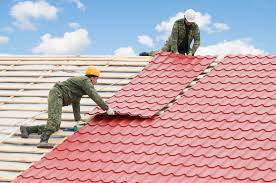The roof is an essential component of any house, providing protection from the elements and keeping the interior of the house dry and comfortable. Choosing the right roofing material is crucial for ensuring the longevity, durability, and efficiency of your roof. In this article, we will discuss some of the best roofing materials for houses, their pros and cons, and what to consider when making your choice.
Asphalt Shingles:
Asphalt shingles are the most popular roofing material in the United States due to their affordability, versatility, and ease of installation. They come in a variety of colors and styles, including 3-tab, architectural, and designer shingles. They have a lifespan of 20-30 years and require regular maintenance, such as cleaning and replacing damaged shingles. The main downside of asphalt shingles is that they are not very environmentally friendly, as they are made from petroleum-based products and generate a lot of waste.
Metal Roofing:
Metal roofing is a durable and long-lasting roofing material that comes in a variety of styles, including standing seam, corrugated, and metal shingles. It is highly resistant to extreme weather conditions, such as hail, high winds, and fire. It is also energy-efficient, as it reflects heat from the sun, reducing cooling costs in the summer. However, metal roofing is more expensive than asphalt shingles and requires professional installation. It can also be noisy during rain or hail storms.
Clay and Concrete Tiles:
Clay and concrete tiles are popular roofing materials in warm, dry climates due to their durability, fire resistance, and energy efficiency. They come in a variety of colors and styles, including Spanish, mission, and slate tiles. They have a lifespan of 50-100 years and require minimal maintenance, such as cleaning and replacing cracked tiles. However, they are heavy and require a reinforced roof structure to support their weight. They are also more expensive than asphalt shingles and require professional installation.
Slate:
Slate is a natural stone roofing material that is highly durable and long-lasting, with a lifespan of 100 years or more. It comes in a variety of colors and styles, including black, gray, green, and red. It is fire-resistant, low-maintenance, and environmentally friendly, as it is a natural material. However, the slate is very heavy and requires a reinforced roof structure to support its weight. It is also expensive and requires professional installation.
Wood Shingles and Shakes:
Wood shingles and shakes are a natural roofing material that adds a rustic, traditional look to a house. They come in a variety of woods, including cedar, redwood, and pine. They have a lifespan of 30-50 years and require regular maintenance, such as cleaning, staining, and replacing damaged shingles. They are also environmentally friendly, as they are a natural material. However, they are not fire-resistant and can be more prone to rot and decay than other roofing materials. They are also more expensive than asphalt shingles and require professional installation.
Synthetic Roofing:
Synthetic roofing materials, such as plastic, rubber, and polymer, are becoming increasingly popular due to their durability, low maintenance, and affordability. They come in a variety of styles and colors, including slate, cedar shake, and tile. They are lightweight and easy to install, making them a popular choice for DIY projects. They are also fire-resistant, energy-efficient, and environmentally friendly, as they are often made from recycled materials. However, synthetic roofing materials may not have the same aesthetic appeal as natural materials and may not be as durable in extreme weather conditions.roofing materials for houses
When choosing a roofing material for your house, it’s important to consider the following factors:
Cost:
The cost of the roofing material, including installation and maintenance, should be a primary consideration when choosing a roofing material. Some materials, such as asphalt shingles and wood shakes, are more affordable than others, such as slate and clay tiles.
Climate:
The climate in your area should also be taken into account. For instance, metal roofing is ideal for areas prone to hail and high winds, while clay and concrete tiles are suitable for warm, dry climates. Consider the weather patterns in your area when making your choice.
Aesthetic Appeal:
The appearance of the roofing material should also be considered, as it can have a significant impact on the overall look of your house. Choose a material that complements the style and architecture of your house.
Durability and Maintenance:
The durability and maintenance requirements of the roofing material should also be taken into account. Consider how long the material is likely to last, how often it will need maintenance, and how easy it is to repair or replace damaged sections.
Environmental Impact:
The environmental impact of the roofing material should also consider. Some materials, such as asphalt shingles, are not environmentally friendly and generate a lot of waste, while others, such as wood shakes, are more sustainable and natural.
In conclusion, choosing the best roofing material for your house requires careful consideration of various factors, including cost. Climate, aesthetic appeal, durability, maintenance requirements, and environmental impact. By taking these factors into account, you can make an informed decision that ensures the longevity, durability, and efficiency of your roof while also enhancing the overall appearance of your house.roofing materials for houses

